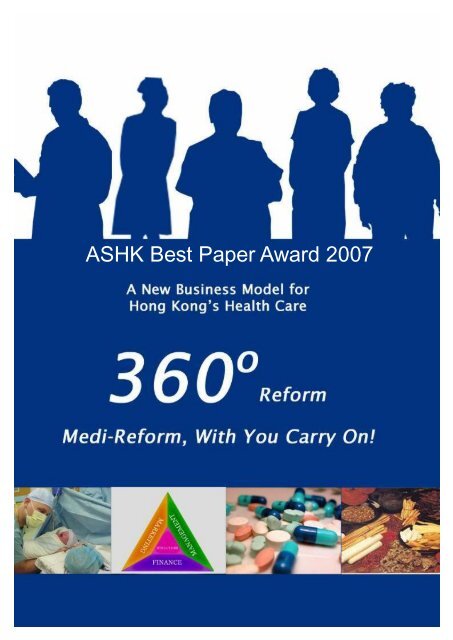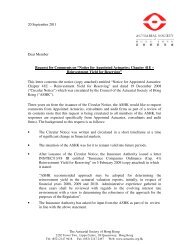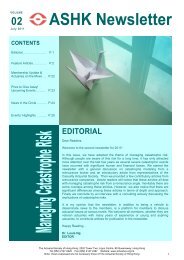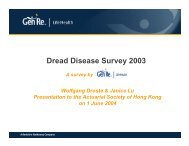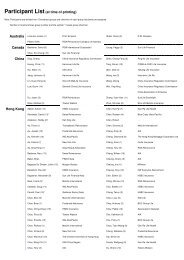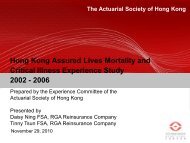1 - Actuarial Society of Hong Kong
1 - Actuarial Society of Hong Kong
1 - Actuarial Society of Hong Kong
You also want an ePaper? Increase the reach of your titles
YUMPU automatically turns print PDFs into web optimized ePapers that Google loves.
ASHK Best Paper Award 2007<br />
1
Executive Summary<br />
<strong>Hong</strong> <strong>Kong</strong>’s Health Care System has been reputed as high quality <strong>of</strong> medical services and fair<br />
access <strong>of</strong> medical resources within the society for long. However, many statistics appeared to show<br />
that the sustainability <strong>of</strong> the system may not be able to maintain for long in terms <strong>of</strong> finance and its<br />
flexibility to respond the potential threats posted on it. Immediate reform is urgently needed to<br />
build up a healthy Health Care System.<br />
The 360 o<br />
Reform mainly focuses on quality assurance, efficiency, risk pooling as well as<br />
financial sustainability.<br />
By introducing the Family Doctors Scheme (FDS), the imbalance <strong>of</strong> burden between the<br />
public-private hospitals and also the financial burden to the public sector can be successfully<br />
reduced. Besides, the FDS proposed, also helps further consolidate the status <strong>of</strong> Chinese Medicine<br />
and incorporate it into the core Health Care System. In addition, Health Information Infrastructure<br />
(HII), as a supplementary tool, encourages the collaboration <strong>of</strong> the different entities within the<br />
health care sectors with a centralized and computerized system. As a result, all the<br />
compartmentalized institutions with a lack <strong>of</strong> interface can increase their collaboration through the<br />
system.<br />
Due to the severe aging population and increasing demand for health care services, a long-term<br />
financing should be developed to help maintain financial sustainability.<br />
Health Protection<br />
Account (HPA) and Public Medical Fund (PMF) are proposed to be the most optimal projects<br />
suiting <strong>Hong</strong> <strong>Kong</strong> environment.<br />
Every part <strong>of</strong> the 360 o Reform are mutually correlated and benefited as they form a whole picture<br />
<strong>of</strong> the most suitable health care model for <strong>Hong</strong> <strong>Kong</strong>. It is believed that the comprehensive reform<br />
is dedicated to solve the present and potential threats posted on the health care system.<br />
Medi-Reform, With You Carry On!<br />
1
Present Health Care Delivery System<br />
Overviews<br />
Supported by the Harvard Report in 1997, the current Health Care System <strong>of</strong> <strong>Hong</strong> <strong>Kong</strong> is<br />
undoubtedly renowned for its high quality <strong>of</strong> medical services and fair access <strong>of</strong> medical resources<br />
across different income groups at low fee. However, the Report and the Department <strong>of</strong> Health 1<br />
coincidentally expected the public health expenditure would reach 20-23% in 2016. The burden<br />
would also increase everlastingly due to the aging population and severely increasing demand for<br />
health care services. And now, the forecast comes true.<br />
In 2001, the Hospital Authority first experienced a deficit <strong>of</strong> HK$250million, while recently raised<br />
to HK$1billion 2 . It is undoubted that the sustainability <strong>of</strong> the sector has already been posted a great<br />
concern to the public. Instant response and proper reform should be carried out immediately.<br />
Several problems are identified in contributing to the current “unhealthy” Health Care System.<br />
First, currently over 90% <strong>of</strong> the secondary and tertiary cares in <strong>Hong</strong> <strong>Kong</strong> are predominated by<br />
public sector, extensive and long-term cares are even exclusively provided by the Hospital<br />
Authority. The serious imbalance <strong>of</strong> burden between the public and private hospitals leads to<br />
financial non-sustainability and there is a rising tendency to attach increasing importance to private<br />
primary care.<br />
Second, the Chinese Medicine has posted a great importance on health care <strong>of</strong> <strong>Hong</strong> <strong>Kong</strong> people.<br />
Demand is not satisfied and yet so far there are only 3 public clinics providing Chinese Medicine<br />
outpatient services, which is far from the plan <strong>of</strong> promised by the government in 2001. There are<br />
about 5133 Registered Chinese Medicine Practitioners in <strong>Hong</strong> <strong>Kong</strong> 3<br />
and the government has an<br />
obligation to cater for their needs. Also, Chinese Medicine is playing a more important role in the<br />
international Health Care. <strong>Hong</strong> <strong>Kong</strong> is definitely the most suitable place to firstly incorporate<br />
and promote the “Combination <strong>of</strong> Traditional Chinese Medicine and Western Medicine” with high<br />
1 Announced by the Secretary <strong>of</strong> the Department <strong>of</strong> Health in 1999<br />
2 Hospital Authority, Annual Report 2005-2006<br />
3 Statistics released in 2005 and with additional 2957 Listed Chinese Medicine Practitioners in <strong>Hong</strong> <strong>Kong</strong><br />
2
quality <strong>of</strong> medical services and acts as a role model to the international. Therefore there is a great<br />
need to qualify, consolidate and systemize the Chinese Medicine in the reform so as to<br />
accommodate the needs <strong>of</strong> the public.<br />
Third, <strong>Hong</strong> <strong>Kong</strong>’s health care system composes <strong>of</strong> compartmentalized institutions with a lack <strong>of</strong><br />
interface across different levels <strong>of</strong> care. Pr<strong>of</strong>essional, informational and price differentiations lead<br />
to a lack <strong>of</strong> cohesion and cooperation between the public and private sectors.<br />
Forth, the public always confuse <strong>of</strong> the roles and responsibilities <strong>of</strong> different health care entities,<br />
and this lead to the problem <strong>of</strong> “doctor-shopping”, which means the public know little about from<br />
which doctors they should seek for help. As a result, patients are not assured to receive the best<br />
medical treatments and protection.<br />
Performance Reviews<br />
SWOT analyses provide a framework for analyzing the internal and external environments <strong>of</strong> the<br />
Health Care Delivery System so as to give a clear direction for reform.<br />
Strengths: 1. Optimal Health Care Model with high cost effectiveness and efficiency<br />
2. Well-established health indicator and fair access <strong>of</strong> medical resources<br />
Weaknesses: 1. Heavy subsidization covers 90% medical services from government<br />
2. Weak collaboration within the whole Health Care Sector<br />
3. Imbalance burden between the public sectors and the private sectors<br />
Opportunities: 1. Support future Chinese Medicine development<br />
2. Increasing and consolidating international status with health pr<strong>of</strong>ession<br />
Threats: 1. Increasing demand for health care services due to aging population and mainland influx<br />
2. Increasing budget deficit which leads to financial non-sustainability <strong>of</strong> the sector<br />
To sum up, the weaknesses <strong>of</strong> the internal environments lead to the financial non-sustainability and<br />
improper resource allocation <strong>of</strong> the Health Care System while the external environments post<br />
potential threatening risks.<br />
3
Key Issues<br />
Strategic reform focuses on balancing the burden between the public and private sectors and<br />
consolidating financial sustainability <strong>of</strong> the Health Care System.<br />
A New Business Model for <strong>Hong</strong> <strong>Kong</strong>’s Health Care – 360 o Reform<br />
Mission<br />
To create a sustainable Health Care Delivery System with optimal resource allocation.<br />
360 o Reform – Medi-Reform, With You Carry On!<br />
Consider every part <strong>of</strong> the Health Care System, the all-rounded 360 o Reform<br />
can be symbolized as an equal triangle with 4 parts, Structure, Management,<br />
Finance and Marketing which are highly correlated and linked. Structure<br />
refers to the underlying modification <strong>of</strong> the fundamental System.<br />
Management refers to how the Reform is going to be managed and ensure the smoothness <strong>of</strong><br />
implementation while Finance refers to the Financing for the public. Lastly, the Marketing refers to<br />
the Action Plans, including the education, promotion, public relations for the whole Reform.<br />
Objectives<br />
The 360 o Reform emphasizes on quality assurance, efficiency, risk pooling as well as financial<br />
sustainability.<br />
1. To reallocate resource from the public sector to the private sector by Repositioning and<br />
Family Doctors Scheme (FDS)<br />
2. To raise the status <strong>of</strong> Chinese Medicine in Health Care Sector and increase the<br />
collaboration with present Health Care entities<br />
3. To improve the collaboration within the Health Care Sector by Health Information<br />
Infrastructure (HII)<br />
4. To maintain financial sustainability and to decrease financial deficit by Health Protection<br />
Account (HPA) and Public Medical Fund (PMF)<br />
4
Modified Structure <strong>of</strong> the Health Care System<br />
A clear position <strong>of</strong> different health care sectors could result in better utilization <strong>of</strong> limited medical<br />
resources and ensure the quality <strong>of</strong> medical services. Besides, the public will no longer confuse<br />
their different functions and responsibilities so that money and time would be saved from<br />
doctor-shopping. Therefore, more specific roles and responsibilities should be firstly established<br />
and educated to the public before the whole reform. The chart below shows the most optimal<br />
structure <strong>of</strong> Health Care Sector in <strong>Hong</strong> <strong>Kong</strong>:<br />
Public Sector: With high subsidization from the government, the public health sector should<br />
continuously target its services at tertiary care, acute care (A&E services), and secondary<br />
treatments to illnesses that entail advanced medical techniques and high cost as well as nurturing<br />
medical pr<strong>of</strong>essionals. Therefore, it can provide long-term and quality medical services to the<br />
public. In addition, public health sector should always act as a safety net to the low-income and<br />
under-privileged group with the subsidization from the government.<br />
Private sector: Private Sector includes all private hospitals, private clinics and private medical<br />
specialists. This sector should promote its quality services to most secondary and tertiary care and<br />
share the burden <strong>of</strong> extensive and long term cares in an affordable price to most medium income<br />
group.<br />
5
Family Doctors Scheme (FDS): FDS is a scheme promoting the adoption <strong>of</strong> Family Doctors.<br />
Family Doctors provide patients with primary, holistic, preventive, comprehensive and continuous<br />
care. In the scheme, it includes two streams <strong>of</strong> services, Western Medicine and Chinese Medicine.<br />
Fund Authority: The Authority would be responsible for holding the two proposed financing plans<br />
for the public, Health Public Account (HPA) and Public Medical Fund (PMF).<br />
With this new positioning structure, people would be clearer to the different roles and<br />
responsibilities <strong>of</strong> the public-private sectors and therefore reduce the misallocation <strong>of</strong> resources. In<br />
addition to the modification <strong>of</strong> the Health Care Structure, the roles <strong>of</strong> medical practitioners and<br />
pharmacists should also be repositioned so as to increase the overall quality <strong>of</strong> health care services.<br />
Commission on the Future <strong>of</strong> Health Care: The commission is set up for the planning and<br />
implementing the whole 360 o Reform.<br />
Medical Council (MC): As an independent entity from the Hospital Authority, MC would<br />
monitor the health care services from different sectors by holding Performance Evaluation Scheme<br />
(PES) in a continuous basis and handling complaints from the public by the modified Complaint<br />
System, in which more representatives from the public and non-government organization (NGO)<br />
would be invited as the advisors in order to increase the transparency <strong>of</strong> the Health Care Sectors<br />
and the public’s confidence to the reform.<br />
Department <strong>of</strong> Health: The department will continue and strengthen to safeguard the health <strong>of</strong><br />
community through preventive, curative and rehabilitative services.<br />
Family Doctors Scheme (FDS)<br />
According to the statistics released from the Hospital Authority (HA), there is an estimation <strong>of</strong><br />
2.6million person-time using the Accident and Emergency Services while 9.5million person-time<br />
using the General Out-patient services in one year. In 2000, the HA conducted a survey and found<br />
out that there was more than 20% <strong>of</strong> abuse <strong>of</strong> A&E services which costs HK$200million <strong>of</strong><br />
6
government expenditure 4 . It shows that the abuse <strong>of</strong> A&E services and outpatient services has been<br />
serious for years and it has posted severe but dispensable financial expenses to the public health<br />
care sector. The convenience and low charges <strong>of</strong> A&E and outpatient services contribute a lot to<br />
the abuse <strong>of</strong> the service use.<br />
While in the eyes <strong>of</strong> the public, the key factor lies on the inaccurate and not well-established<br />
concept on distinctive and unique functions <strong>of</strong> different health care entities.<br />
In addition, as mentioned in Overviews, the development <strong>of</strong> Chinese Medicine should be further<br />
rooted into the major Health Care System. It is definitely the most optimal and appropriate time to<br />
develop a systematic collaboration with the existing Health Care entities through concrete action.<br />
In order to reduce the abuse <strong>of</strong> the two mentioned public services, as well as to develop a clear<br />
concept <strong>of</strong> use <strong>of</strong> health care services for the public and to raise the status <strong>of</strong> Chinese Medicine,<br />
enhancing the amount and quality <strong>of</strong> Family Doctors is the most cost effective measure. Its<br />
ultimate goals also contribute to the balancing <strong>of</strong> burden from public sector to private one and<br />
provide the best medical care in the long-term.<br />
Features<br />
In the 360 o Reform, Family Doctor Scheme aims at<br />
upgrading the clinical knowledge <strong>of</strong> all private general<br />
practitioners to equip them to be the community health<br />
gatekeepers and ease the heavy burden <strong>of</strong> out-patient<br />
services in public hospital. At the same time, it is a<br />
strengthened network between doctors in all clinics by a<br />
computerized system – HII that would be introduced<br />
later. Every diagnosis to the patients should be recorded through the computerized system and<br />
shared by appointed doctors in giving medical treatments. The complete and chronological medical<br />
records would help in investigating chronic and hereditary diseases. Family doctors are also<br />
4 According to the HA, the average cost for the A&E services for one patient’s visit is HK$800<br />
7
esponsible for referring the patients to different medical specialists if necessary. There are two<br />
streams <strong>of</strong> FDS, the Western Medicine and the Chinese Medicine. It is compulsory that all western<br />
general practitioners in <strong>Hong</strong> <strong>Kong</strong> should join this Family Doctor Scheme while it is optional for<br />
yet encouraged the Chinese Medicine Doctors to join this scheme. This serves to respond the<br />
increasing demand on primary health care in Chinese Medicine and provide a more systematic<br />
management on its development.<br />
According to the international standard 5 , every family doctor can take care <strong>of</strong> 2000 patients.<br />
Presently, there are about 100 Family Doctors <strong>of</strong> Western Medicine are in <strong>Hong</strong> <strong>Kong</strong>, which is<br />
1% <strong>of</strong> the total medical practitioners. Under the present situation, it would take more than 40 years<br />
for every HK citizen to have their own family doctor 6 . Therefore, the FDS is suggested to provide<br />
and promote the Diploma <strong>of</strong> Family Doctors (Western Medicine) for Western Medicine and<br />
Certificate <strong>of</strong> Family Doctors (Chinese Medicine) for Chinese Medicine while instantaneously<br />
develops a Family Doctors Development Fund for continuous and more extensive Vocational<br />
Training Programme.<br />
Diploma <strong>of</strong> Family Doctors (Western Medicine): A 2-year programme provided by the <strong>Hong</strong> <strong>Kong</strong><br />
College <strong>of</strong> Family Physicians includes the general knowledge <strong>of</strong> Family Medicine. The<br />
qualification <strong>of</strong> the diploma ensures the clinical doctors have the ability and infrastructure to deal<br />
with all the primary care. The primary care here refers to the Level V - Non-urgent and Level VI -<br />
Semi-urgent according to the Triage System in Accident and Emergency Department. Besides, the<br />
diploma ensures the family doctors would be capable to refer the patient to different medical<br />
specialists.<br />
Certificate <strong>of</strong> Family Doctors (Chinese Medicine): Current Chinese Medicine can take the<br />
Certificate which lasts for 6 months to learn about the present Health Care System in <strong>Hong</strong> <strong>Kong</strong><br />
so as to be more incorporated in the structure. They also learn about the use and functions <strong>of</strong> the<br />
5 According to the standard from the World Health Organization (WHO)<br />
6 The Vocational Training Programme takes 6-year in Family Medicine <strong>of</strong> the <strong>Hong</strong> <strong>Kong</strong> College <strong>of</strong> Family<br />
Physicians and present maximum quota for the programme is about 80 every year.<br />
8
computerized system, Health Information Infrastructure (HII) to record diagnosis. As the Chinese<br />
Medicine becomes more well-developed in <strong>Hong</strong> <strong>Kong</strong>, the Family Doctor (Chinese Medicine)<br />
can use the HII system to refer the patient to different Chinese Medicine specialists.<br />
The diploma mainly targets at the current 4500 Western and while the Certificate targets the 5000<br />
Chinese Medicine clinical doctors in <strong>Hong</strong> <strong>Kong</strong>, so as to upgrade their qualification on providing<br />
primary, comprehensive and continuous care to the patients. Combining with distance-learning and<br />
clinical diagnosis, the diploma can be provided to 800 clinical doctors every year. In sever years<br />
time, about 50% <strong>of</strong> the clinical doctors will achieve the qualifications <strong>of</strong> the Diploma <strong>of</strong> Family<br />
Doctors.<br />
Implementation<br />
Collaboration: There will be a close contact with the Medical Specialists <strong>of</strong> Chinese Medicine like<br />
the Registered Chinese medicine practitioner (Acupuncture)” and “Registered Chinese medicine<br />
practitioner (Bone-setting)” as the Family Doctors <strong>of</strong> Chinese Medicine can refer the patients to<br />
different specialists <strong>of</strong> the sector. As a result, patients can receive the most appropriate and<br />
comprehensive medical treatments.<br />
Participation <strong>of</strong> the Public: To successful shift the burden <strong>of</strong> out-patient services and retargets the<br />
A&E services to the people in real need in public hospital by FDS, supportive participation from<br />
the public is a must. Public will be educated on the distinct roles <strong>of</strong> different health entities and<br />
there are also financial incentives to encourage a proper use <strong>of</strong> A&E services in public hospital by<br />
approaching their family doctor.<br />
Family Doctors Development Fund: As mentioned, the number <strong>of</strong> family doctors should be<br />
uplifted. A funding should be available for the training <strong>of</strong> family doctors with subsidization.<br />
9
Education: Education is another important tool to the development. Starting from schools and mass<br />
media, the <strong>Hong</strong> <strong>Kong</strong> citizens would be well educated about the benefits <strong>of</strong> joining the scheme.<br />
Benefits<br />
FDS acts as the health gatekeepers <strong>of</strong> the community and therefore helps in soothing the great<br />
demand for public health care services, especially the Accident and Emergency services.<br />
According to the Hospital Authority, HK$200million would be saved by shifting the “non-urgent”<br />
and “second urgent” services to the private sectors. Besides, the family doctors can act as a<br />
promotion channel <strong>of</strong> any health messages delivered to the patients like the prevention <strong>of</strong> flu to the<br />
whole family. It is also noteworthy that FDS helps providing a concrete status and a clearer<br />
direction for the future development <strong>of</strong> Chinese Medicine in <strong>Hong</strong> <strong>Kong</strong>.<br />
Health Information Infrastructure (HII)<br />
Compartmentalization problem obviously undermines the efficiency and quality <strong>of</strong> <strong>Hong</strong> <strong>Kong</strong>’s<br />
health care services. Integration <strong>of</strong> and collaboration among all health care entities are necessary to<br />
recover the public’s confidence towards the general health care in <strong>Hong</strong> <strong>Kong</strong>.<br />
Besides, currently only some public outpatient services produce hand-write medical records for<br />
further referral. The immobility <strong>of</strong> patients’ records attributes to the poor continuity <strong>of</strong> care and a<br />
higher total medical expense for the public.<br />
Features<br />
Health Information Infrastructure<br />
(HII) is a giant information<br />
system which aids the current<br />
problem <strong>of</strong> compartmentalization<br />
and aims to bridge all health care<br />
bodies in <strong>Hong</strong> <strong>Kong</strong> and accelerate the cooperation within them.<br />
10
Database <strong>of</strong> patients’ records: Upon the implementation <strong>of</strong> HII, once a patient utilizes any medical<br />
service, either public or private, his/her personal information and medical history would be<br />
systematically recorded and afterwards, his record would be accessed by the physicians.<br />
Referral system: Physicians can utilize this web-based referral system to request further medical<br />
treatments by making online appointment with the corresponding health care parties like X-ray<br />
analysts or referring the patients to appropriate medical specialists.<br />
Health care network: Different counterparts <strong>of</strong> the Health Care Sector can deliver the latest<br />
health-related news such as implementation <strong>of</strong> new health care policies and outbreak <strong>of</strong> infectious<br />
diseases to all health practitioners and front-line physicians.<br />
Implementation<br />
Establishing the Health Information Infrastructure Advisory Board (HIIAB) is highly<br />
recommended in order to supervise the agencies which may be the technology providers and<br />
system developers on the adoption and use <strong>of</strong> electronic health records.<br />
The government could take reference on the experience <strong>of</strong> implementation <strong>of</strong> similar computerized<br />
system in other regions such as Florida 7 . The first stage which takes 3 years will be sufficient to<br />
build the physical infrastructure component <strong>of</strong> the network, install the master patient index,<br />
develop the web portal, and install the database s<strong>of</strong>tware around a central server that maintains<br />
connectivity within the network. In the second stage, training to access to the network is provided<br />
in the Diploma and Certificate <strong>of</strong> the Family Doctor Scheme and it is expected that the whole<br />
system would start its operations in 5 years. Technical support is necessary to maintain and<br />
evaluate the establishment <strong>of</strong> the network onwards.<br />
7 Architectural Considerations for the Florida Health Information Network Infrastructure<br />
11
Benefits<br />
Undoubtedly HII will address the problem <strong>of</strong> compartmentalization <strong>of</strong> health bodies in <strong>Hong</strong> <strong>Kong</strong>.<br />
The referral system can facilitate the collaboration within the health care sector by effective<br />
referral and transmission <strong>of</strong> patients. The database <strong>of</strong> patients’ records provide the physicians with<br />
better comprehending to their patients by studying their medical history, drug allergies, previous<br />
illnesses, etc. so the patients will receive the most suitable medical treatments which are properly<br />
determined by the physicians. As a result, the quality assurance <strong>of</strong> <strong>Hong</strong> <strong>Kong</strong>’s health care will be<br />
enhanced.<br />
Lastly, HII brings some subsidiary benefits to the whole health care system. The Health Protection<br />
Account (HPA) and Public Medical Fund (PMF), which are the two important elements in our<br />
proposed health care financing model, rely HII on supporting the expenses-calculation work for<br />
patients <strong>of</strong> different income groups.<br />
On public’s side, patients can be referred to their further specialized medical treatments through<br />
HII without delay and unnecessary procedures in which efficiency <strong>of</strong> medical services is achieved.<br />
In addition, HII would help assist the regulator to monitor the health practitioners in which the<br />
public’s worries <strong>of</strong> being treated incorrectly by the doctors can be relieved.<br />
Limitations<br />
Law <strong>of</strong> Privacy: Since HII possesses highly sensitive medical records, to protect the privacy <strong>of</strong><br />
patients, the Board will conduct the Privacy and Security Project before the inception <strong>of</strong> HII. The<br />
project defines the authorities <strong>of</strong> information access for different parties. For instance, doctors are<br />
only allowed to access the patient’s medical pr<strong>of</strong>ile at the time they meet the patient and the access<br />
time should also be recorded by the system.<br />
12
Financing<br />
Health Care is an important portion <strong>of</strong> macro-economy. However, a sustainable health care model<br />
should be financially sound in all economic situations. To achieve this, developing long term<br />
financial strategies are necessary. Here we propose the Public Medical Fund (PMF) and Health<br />
Protection Account (HPA).<br />
(I)Public Medical Fund (PMF) + Restructuring <strong>of</strong> User Fees<br />
Due to the imbalance <strong>of</strong> public-private health sector, the Health Care services incur an amazingly<br />
large portion <strong>of</strong> the government financial budget to over HK$25 billion (about 14%) each year.<br />
The heavy reliance on one particular source <strong>of</strong> fund would result in a potential risk <strong>of</strong> receiving<br />
insufficient fund in case <strong>of</strong> fiscal deficit during economic downturn.<br />
Features<br />
In order to ensure the financial sustainability <strong>of</strong> our proposed model, introducing new sources <strong>of</strong><br />
fund to our medical system to enhance the risk diversification as well as the risk pooling effect is<br />
necessary. To cater this, establishing the Public Medical Fund (PMF) together with restructuring <strong>of</strong><br />
user fees in public medical services is highly recommended.<br />
Adoption <strong>of</strong> PMF: PMF is a pool <strong>of</strong> fund that consists <strong>of</strong> 1% monthly regular salary contribution<br />
from the working population in <strong>Hong</strong> <strong>Kong</strong> as well as further subsidization from the government.<br />
13
By then, government will subsidize the public health sector through the fund instead <strong>of</strong> providing<br />
direct subsidies to Hospital Authority. PMF supports the operations <strong>of</strong> all public medical services<br />
financially and help reprioritize the resources by direct subsidization to needy which will be<br />
explained in next paragraph. As the fund balance accumulates with time as well as a relief in the<br />
public health care usage caused by the repositioning <strong>of</strong> public-private health sector and FDS,<br />
government’s contribution to public medical expenses through PMF will gradually decrease with<br />
the public participation increase.<br />
Restructuring <strong>of</strong> User Fees: To ensure the resources can be prioritized to the patients <strong>of</strong> greatest<br />
needs, a restructuring <strong>of</strong> user fees mechanism should be carried out in parallel with implementation<br />
<strong>of</strong> PMF. It is suggested that the quote fees in public sector should be raised to at least 60% <strong>of</strong> those<br />
<strong>of</strong> similar services in private sector. At the same time, PMF effectively targets the resources by<br />
directly subsidizing patients on their payments <strong>of</strong> public health care treatments according to their<br />
income levels. In other words, patients would be charged differently in public health sector by a<br />
progressive subsidization from PMF towards the less wealthy group.<br />
Implementation<br />
Throughout the implementation <strong>of</strong> PMF, HII would take a very important supportive role, for<br />
example, subsidies from PMF to the public would be determined by the HII system according to<br />
the personal information recorded and special formulas in HII. As mentioned before, the Fund<br />
Authority would be responsible for overseeing the running <strong>of</strong> the fund.<br />
14
Benefits<br />
Better reallocation <strong>of</strong> financial resources: By directly subsidizing the public according to their<br />
income levels, the public medical resources can be prioritized to the most needed. And at the same<br />
time encourage the use <strong>of</strong> private medical services.<br />
Enhancement <strong>of</strong> financial sustainability: By introducing direct participation from the public,<br />
government subsidization can be reduced by at least 12% in the first year, which still have not<br />
taken into account <strong>of</strong> the effect <strong>of</strong> restructuring <strong>of</strong> user fees, and the percentage is expected to grow<br />
in future Appendix I .<br />
Facilitate the reform on structure: By keeping the prices in public sector close to the market,<br />
middle to high income group will be encouraged to seek medical services in private sector and<br />
therefore facilitate our reform in repositioning the heath entities.<br />
Enhancement <strong>of</strong> risk diversification and risk pooling: It is successfully achieved by the medical<br />
fund with equal contribution weight from the working groups.<br />
Facilitate the reform on structure: By keeping the prices in public sector close to the market,<br />
middle to high income group will be encouraged to seek medical services in private sector and<br />
therefore facilitate our reform in repositioning the medical structure.<br />
(II) Health Protection Account (HPA)<br />
To reduce the burden on our next generations caused by heavy heath care utilization by the aged, a<br />
medical savings through the scheme <strong>of</strong> Health Protection Account (HPA) 8<br />
should be implemented<br />
to assist the individual and the spouse for their post-retirement medical expenses.<br />
Features<br />
Health Protection Account is a mandatory medical saving scheme that requires every individual<br />
contributing 2% <strong>of</strong> the earnings to the personal account. The operation <strong>of</strong> this account will be<br />
similar to the existing MPF scheme in <strong>Hong</strong> <strong>Kong</strong> and one can only withdraw the savings until the<br />
8 HPA is first suggested by government in the Health Care Reform Consultation Document in Dec-00. But the features<br />
<strong>of</strong> it have been modified in our proposed model.<br />
15
age <strong>of</strong> 65. Upon withdrawal, one is encouraged to purchase medical insurance to secure the<br />
post-retirement health care from private insurers. After taking into consideration <strong>of</strong> different<br />
insurability and savings across the community, different measures would be carried out<br />
accordingly. The following table summarizes the effect.<br />
Sufficient<br />
savings in<br />
HPA<br />
Positive<br />
Insurability<br />
Purchase<br />
Medical<br />
Insurance<br />
Final outcomes<br />
Yes Yes Yes Medical expenses largely reimbursed by insurance and the<br />
cash outflow <strong>of</strong> HPA would be limited.<br />
Yes Yes No Pay the medical expenses directly using savings in HPA. Yet<br />
if one access public medical services, he or she will receive<br />
no subsidy from PMF, this is to encourage the use <strong>of</strong><br />
insurance to enhance risk pooling.<br />
Yes No N/A Pay the medical expenses directly using savings in HPA.<br />
And this group is eligible to receive the subsidization from<br />
PMF when using public medical services.<br />
No N/A N/A Receive assistance <strong>of</strong> the medical safety net provided by<br />
government if one has difficulty in paying medical<br />
expenses.<br />
Implementation<br />
A Fund Authority is established to manage the HPA <strong>of</strong> the individuals. The contribution can be<br />
incorporated into the collection <strong>of</strong> MPF as to minimize the administrative cost and simplify the<br />
collection procedures<br />
Benefits/Expected Result<br />
From an actuarial analysis conducted, 82% <strong>of</strong> those start contributing HPA before age 40 have<br />
more than sufficient fund to cover their medical expenditures after retirement AppendixII . Currently,<br />
about 45% <strong>of</strong> the HK$30 billion total health expenditure 9<br />
is consumed by those aged at 65 or<br />
above. In long term, over 90% <strong>of</strong> this amount will be self-financed by individuals with the<br />
implementation <strong>of</strong> HPA, and government can save over HK$12 billion per year.<br />
This financing option responds to the unique Chinese culture that individuals are more willing to<br />
contribute to their personal accounts instead <strong>of</strong> a social health insurance; we would expect support<br />
from the community to this program.<br />
9 Source: Annual Report 2005-2006, Hospital Authority<br />
16
Limitation<br />
Moral Hazard: An encouragement <strong>of</strong> the use <strong>of</strong> medical insurance would further increase the<br />
demand on health care due to lower out-<strong>of</strong>-pocket expenditure. But this can be soothed by<br />
introducing deductibles in the insurance coverage.<br />
HPA need longer time to take effect: When the HPA is first implemented, those start contributing in<br />
their middle age may not have sufficiently long period to accumulate medical savings, therefore,<br />
the full effect <strong>of</strong> HPA will take time to effect.<br />
Marketing - Action Plans <strong>of</strong> 360 o Reform<br />
To carry out the whole reform, a comprehensive plan with education, promotion and public<br />
relations is essential to gain support from the general public.<br />
Education: Education helps deliver information <strong>of</strong> the advantages <strong>of</strong> the reform to the community.<br />
Inviting lectures to the schools and sending health ambassadors to the community centre are 2 <strong>of</strong><br />
the ways to achieve this. “Universal coverage for all, not coverage for everything”, as proposed by<br />
World Health Organization on the health issue in the world, would be our focus. On one hand, we<br />
educate the public the long-term benefits <strong>of</strong> the policies to everyone in the society, on the other<br />
hand, everyone is to contribute a part to their own health, such as through the implementation <strong>of</strong><br />
HPA and PHF.<br />
Promotion: It is the most appropriate method to package the 360 o Reform. Mass Marketing would<br />
appeal to the most number <strong>of</strong> the public. Through TV and Paper advertisements before the<br />
consultation <strong>of</strong> the whole reform, information could be well disseminated. Next, Direct Marketing,<br />
such as telemarketing and direct delivery <strong>of</strong> brochure, would be the most effective for promoting<br />
the reforms which are more personal and tailor-made to the individuals such as HPA.<br />
Public Relations: It plays an important role before and during the implementation. A 2-year<br />
consultation period provides chances for the public to express their comments. The government<br />
must well response to the reaction <strong>of</strong> the public as the reform is to benefit the whole community.<br />
17
Budget<br />
General acceptance from the public is the result <strong>of</strong> the clear understanding on a well-planned<br />
budget, which plays an important role in the visionary 360 o Reform.<br />
HK$ million<br />
Family Doctors Scheme (FDS) 2,075<br />
Fund Authority 200<br />
Health Information Infrastructure 1,000<br />
Total 3,275<br />
Expected Expenditure on FDS = Subsidization on Diploma + Subsidization on Certificate<br />
= ($250,000/yr x 2yrs x 90%sub x 4500) 10 + 50 million 11 = HK$2,075,000,000<br />
Referencing Mandatory Provident Fund Schemes Authority, the administration expense <strong>of</strong> the<br />
Fund Authority is estimated as HK$200 million.<br />
Referencing the Health Information Infrastructure (HII) system in other countries such as USA 12 ,<br />
and considering the factor in population, number <strong>of</strong> doctors and country size, the cost <strong>of</strong><br />
implementing HII is estimated as HK$1 billion.<br />
The major total cost underlying the whole reform is HK$3.275 billion.<br />
Risk Assessment<br />
The implementation <strong>of</strong> the whole reform may undergo certain scenario with uncontrollable risk.<br />
Economic downturn is one among these risks.<br />
A research in 2004 13<br />
shows that the low-income group have a higher acceptance on Health<br />
Protection Account (HPA) because they believe the system secure better medical protection.<br />
10 Referencing the cost <strong>of</strong> receiving education on Degree <strong>of</strong> Medicine every year<br />
11 Referencing the cost <strong>of</strong> receiving a certificate each module<br />
12 U.S. Department <strong>of</strong> Health & Human Services, Health Information Technology<br />
13 From “A Study on Health Care Financing and Feasibility <strong>of</strong> a Medical Savings Scheme in <strong>Hong</strong> <strong>Kong</strong>” by Health,<br />
Welfare and Food Bureau in 2004<br />
18
However, as the Mandatory Provident Fund (MPF) has been in operation for just a few years, the<br />
general public is still adjusting to this contributory scheme. The timing <strong>of</strong> implementation <strong>of</strong><br />
Health Protection Account (HPA) and Public Medical Fund (PMF) should take into account <strong>of</strong> the<br />
prevailing economic situation. When economic downturn comes, citizens may not support<br />
contributing a part <strong>of</strong> their salary into the two funds.<br />
Despite many long-term benefits, the establishment <strong>of</strong> Health Information Infrastructure and<br />
Family Doctor Scheme cost large amount <strong>of</strong> capital. It may face some resistance in the Legislative<br />
Council especially when the overall economic situation is not good.<br />
To successfully benefit the community, a suitable and lengthy timing <strong>of</strong> consultation and<br />
implementation is needed. It is suggested to choose a time when the prospect <strong>of</strong> economy is<br />
satisfactory and so the benefits and financial concerns are well-balanced during discussion.<br />
Conclusion<br />
After analyzing the current health care system, we have identified areas in the system which has<br />
room for improvement. To ease with the imbalance <strong>of</strong> the two health sectors and to maintain the<br />
financial sustainability, 360 o Reform definitely can continuously help the health care system to<br />
fulfill the community’s needs in the long run. The proposed changes are mutually correlated and<br />
benefited as they support each other and form a whole picture <strong>of</strong> the most suitable health care<br />
model for <strong>Hong</strong> <strong>Kong</strong>. It is believed that the comprehensive reform is dedicated to solve the<br />
present and potential threats posted on the health care system.<br />
19
To Look Ahead<br />
Other than the concrete structure and supportive financial strategies proposed above, there are<br />
always further steps under consideration after the success <strong>of</strong> the 360 o Reform, Separation <strong>of</strong> Drug<br />
Prescribing from Dispensing is among one <strong>of</strong> them.<br />
Separation <strong>of</strong> Drug Prescribing from Dispensing<br />
Currently, the clinical doctors are responsible both in prescribing and dispensing. Due to the<br />
potential existence <strong>of</strong> moral hazard in this practice, the concept <strong>of</strong> the separation <strong>of</strong> drug<br />
prescribing from dispensing should be adopted. Similar to many Western countries like U.S. and<br />
Canada, the responsibility <strong>of</strong> dispensing medicine is borne by the qualified pharmacists. Being<br />
applied in the primary care <strong>of</strong> the health care system, the new practice would reduce medical error<br />
due to drugs dispense by unqualified party. Being no longer influenced and deviated by the<br />
financial incentive, the medical practitioners would appropriately prescribe drugs with optimal<br />
treatment instead <strong>of</strong> gaining high pr<strong>of</strong>it margin from dispensing drugs. Patients can, in addition,<br />
benefit from getting extra opinions on their medication from pharmacists; and this mutual<br />
monitoring system on medication would definitely promote the quality assurance.<br />
To Sum up, focusing on quality, efficiency, risk pooling and financial sustainability is the core idea<br />
<strong>of</strong> the 360 o Reform. With the support from health sectors, government and the public, we would<br />
expect a huge success in the 360 o Reform that creates a well-fit health care model in <strong>Hong</strong> <strong>Kong</strong>. It<br />
is hoped that <strong>Hong</strong> <strong>Kong</strong>’s health care system can continue to improve, and provide its citizens<br />
with the best it can.<br />
20
Appendix I<br />
Contribution to PMF by Public<br />
Here we take MPF in the situation <strong>of</strong> year 2005 as an example to illustrate the contribution to<br />
Public Medical Fund (PMF) by the public.<br />
HK$ 3.2 billion is about 10.5% <strong>of</strong> the total public medical expenditure in year 2005.<br />
Sources:<br />
“Mandatory Provident Fund Schemes Statistical Digest”<br />
http://www.mpfahk.org/tc_chi/quicklinks/quicklinks_sta/files/Dec_2005_SD.pdf<br />
1
Appendix II<br />
<strong>Actuarial</strong> Illustration <strong>of</strong> the HPA Scheme<br />
This actuarial study was conducted by the Health, Welfare and Food Bureau aimed to assess the extent<br />
<strong>of</strong> protection <strong>of</strong>fered by HPA contributors for their post-retirement health care spending. The<br />
simulation model assumes 2% contribution <strong>of</strong> income, 2% annual interest rate and 1% annual medical<br />
inflation.<br />
Starting Age <strong>of</strong><br />
Contribution<br />
20-29<br />
30-39<br />
40-49<br />
50-64<br />
Monthly Income % <strong>of</strong> HPA Accounts<br />
with Positive Balance*<br />
Average Surplus with<br />
Positive Account Balance**<br />
$5000-$9999 83.0% $128000<br />
$10000-$19999 95.3% $226000<br />
$20000 or above 96.6% $252600<br />
Overall 90.3% *** $192200<br />
$5000-$9999 53.7% $54900<br />
$10000-$19999 86.9% $128000<br />
$20000 or above 93.5% $162600<br />
Overall 81.8% $130900<br />
$5000-$9999 26.8% $26600<br />
$10000-$19999 65.6% $61800<br />
$20000 or above 81.7% $86000<br />
Overall 58.6% $67200<br />
$5000-$9999 7.5% $11200<br />
$10000-$19999 26.2% $23900<br />
$20000 or above 44.7% $34500<br />
Overall 22.2% $26900<br />
* “% <strong>of</strong> HPA Accounts with Positive Balance” means savings in the account are sufficient to cover<br />
all the post-retirement medical expenditure<br />
** “Average Surplus with Positive Account Balance” means average amount left in the HPA after one<br />
is died. Only those with residue in the accounts after death are taken into consideration. And the<br />
surplus would be passed to the inheritors <strong>of</strong> the individual.<br />
*** In the long run, 90% <strong>of</strong> the population will have sufficient medical savings to secure their health<br />
care after retirement at age 65; therefore, government’s financial burden due to excessive usage <strong>of</strong><br />
medical services by the aged will be reduced by 90%.<br />
2
A diagram further shows the effect <strong>of</strong> HPA across different income groups with different starting age<br />
<strong>of</strong> contribution is as follow.<br />
Starting Age <strong>of</strong> Contribution<br />
% <strong>of</strong> HPA Accounts with sufficient<br />
amount to for medical expense after<br />
retirement<br />
100.00%<br />
90.00%<br />
80.00%<br />
70.00%<br />
60.00%<br />
50.00%<br />
40.00%<br />
30.00%<br />
20.00%<br />
10.00%<br />
20-29<br />
30-39<br />
40-49<br />
50-64<br />
0.00%<br />
5,000-9,999 10,000-19,999 >20,000<br />
Monthly Income<br />
This graph clearly illustrates the benefit to the individuals. For those who start contributing at age 20<br />
to 29, over 90% can self-finance their medical expense after retirement. This does not only ensure the<br />
majority has a secured protection against medical expense, but also eases the financial burden <strong>of</strong> the<br />
government.<br />
Source:<br />
“A Study on Health Care Financing and Feasibility <strong>of</strong> a Medical Savings Scheme in <strong>Hong</strong> <strong>Kong</strong>” by<br />
Health, Welfare and Food Bureau in 2004<br />
3


